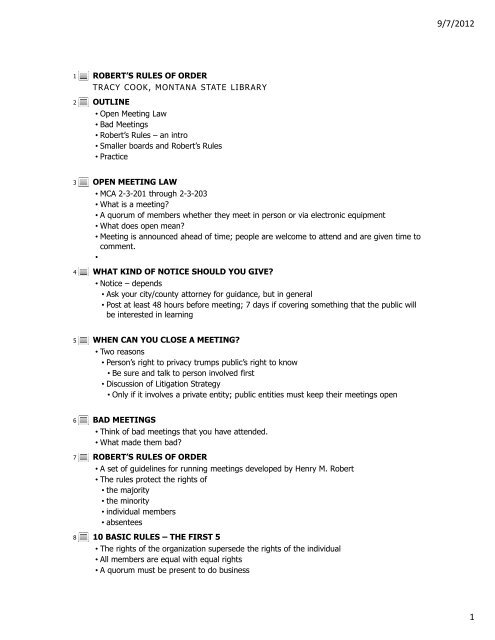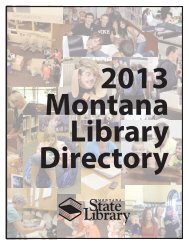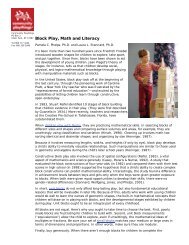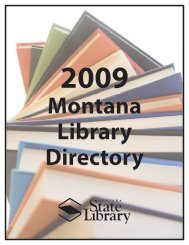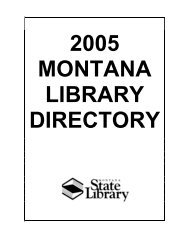Robert's Rules of Order
Robert's Rules of Order
Robert's Rules of Order
Create successful ePaper yourself
Turn your PDF publications into a flip-book with our unique Google optimized e-Paper software.
9/7/2012<br />
1<br />
2<br />
ROBERT’S RULES OF ORDER<br />
TRACY COOK, MONTANA STATE LIBRARY<br />
OUTLINE<br />
• Open Meeting Law<br />
• Bad Meetings<br />
• Robert’s <strong>Rules</strong> – an intro<br />
• Smaller boards and Robert’s <strong>Rules</strong><br />
• Practice<br />
3<br />
4<br />
OPEN MEETING LAW<br />
• MCA 2-3-201 through 2-3-203<br />
• What is a meeting<br />
• A quorum <strong>of</strong> members whether they meet in person or via electronic equipment<br />
• What does open mean<br />
• Meeting is announced ahead <strong>of</strong> time; people are welcome to attend and are given time to<br />
comment.<br />
•<br />
WHAT KIND OF NOTICE SHOULD YOU GIVE<br />
• Notice – depends<br />
• Ask your city/county attorney for guidance, but in general<br />
• Post at least 48 hours before meeting; 7 days if covering something that the public will<br />
be interested in learning<br />
5<br />
WHEN CAN YOU CLOSE A MEETING<br />
• Two reasons<br />
• Person’s right to privacy trumps public’s right to know<br />
• Be sure and talk to person involved first<br />
• Discussion <strong>of</strong> Litigation Strategy<br />
• Only if it involves a private entity; public entities must keep their meetings open<br />
6<br />
7<br />
8<br />
BAD MEETINGS<br />
• Think <strong>of</strong> bad meetings that you have attended.<br />
• What made them bad<br />
ROBERT’S RULES OF ORDER<br />
• A set <strong>of</strong> guidelines for running meetings developed by Henry M. Robert<br />
• The rules protect the rights <strong>of</strong><br />
• the majority<br />
• the minority<br />
• individual members<br />
• absentees<br />
10 BASIC RULES – THE FIRST 5<br />
• The rights <strong>of</strong> the organization supersede the rights <strong>of</strong> the individual<br />
• All members are equal with equal rights<br />
• A quorum must be present to do business<br />
1
9/7/2012<br />
•<br />
• A simple majority rules unless otherwise stipulated in the bylaws<br />
• Silence means consent<br />
9<br />
10<br />
11<br />
12<br />
1<br />
2<br />
1<br />
2<br />
THE SECOND 5 RULES<br />
• Two-thirds vote rule – necessary when limiting or taking away the rights <strong>of</strong> members<br />
• Motions must receive full debate – no motion to vote may be made if members wish to<br />
continue debate unless 2/3 agree<br />
• One question at a time – one speaker at a time<br />
• Once a decision is made an identical motion may not be brought forward at the same<br />
meeting<br />
• Personal remarks ARE always out <strong>of</strong> order<br />
MOTIONS – THE HEART OF THE RULES<br />
• Main Motion – how business is brought forward<br />
• Secondary motions<br />
• Subsidiary – changes or disposes <strong>of</strong> main motions<br />
• Privileged – not related to main motion, but matters <strong>of</strong> immediate importance<br />
• Incidental motions – procedural questions<br />
• Bring a question again before assembly<br />
MAIN MOTIONS – THE PROCESS<br />
1. Someone makes a motion<br />
2. Chair restates motion and asks for a second<br />
3. Someone else seconds the motion<br />
4. Chair says “it’s been moved and seconded that (restate motion)<br />
5. Chair asks if there is discussion<br />
6. Discussion<br />
7. Chair asks for vote<br />
8. Chair announces result <strong>of</strong> vote<br />
• SMALL BOARD ALERTS (less than 12 people)<br />
• Can discuss issue before making a motion<br />
• Don’t have to have a second<br />
• Members may speak any number <strong>of</strong> times<br />
• Chair can participate in the discussion<br />
THE DETAILS…..<br />
Process<br />
• Someone makes a motion<br />
• Chair restates and asks for a second<br />
• Someone seconds<br />
• Discussion<br />
3<br />
4<br />
Problem<br />
• What if the motion is unclear<br />
• What if the chair restates the motion incorrectly<br />
• What if no one seconds the motion<br />
• What are some <strong>of</strong> the problems that arise in a discussion<br />
•<br />
13<br />
THE DETAILS CONT….<br />
2
9/7/2012<br />
1<br />
2<br />
3<br />
4<br />
Process<br />
• Chair calls for vote<br />
• Aye<br />
• Nay<br />
• Abstain<br />
• Chair summarizes results<br />
• Reporting <strong>of</strong> votes<br />
• Motion is adopted or lost<br />
• Results <strong>of</strong> motion if needed<br />
Problem<br />
• What if chair forgets to ask for no<br />
• What about abstentions Do we have to have them<br />
14<br />
15<br />
16<br />
17<br />
18<br />
19<br />
20<br />
PRACTICE<br />
SUBSIDIARY MOTIONS<br />
• Lay on the table – defers a motion for a more pressing matter (NOT used to kill a motion)<br />
• Postpone indefinitely – how you really kill a motion<br />
• Amend – for clarification<br />
• Refer to a Committee – committee investigates<br />
• Postpone definitely – deal with a motion at a certain time or after a certain event<br />
AMEND<br />
• AMENDMENTS MUST BE GERMANE<br />
• They can’t bring up a different question; must be related to the main motion<br />
• They shouldn’t change a motion to the point where voting yes would be the same as<br />
voting no on the original motion<br />
• Friendly Amendments – made when someone supports the main motion, but thinks it<br />
needs to be altered to be acceptable.<br />
AMENDMENTS (CONT.)<br />
• Primary and Secondary<br />
• Primary amendment: adds, strikes out, or substitutes words within original motion<br />
• Secondary amendment/amendment to the amendment: changes the wording <strong>of</strong> the<br />
primary Amendment<br />
GUIDELINES FOR AMENDMENTS<br />
• Can only have a primary and secondary amendment at any given time. Will have to deal<br />
with the secondary amendment before making changes to it.<br />
• Adopting to amend something = accepting the amendment. Still need to vote on (now)<br />
amended main motion<br />
• Rejecting amendment = main motion still exists in its original form<br />
SUBSIDIARY MOTIONS – PRACTICE TIME<br />
• Amend – for clarification<br />
• Refer to a Committee – committee investigates<br />
• Postpone definitely – deal with a motion at a certain time or after a certain event<br />
•<br />
•<br />
PRIVILEGED MOTIONS<br />
3
9/7/2012<br />
21<br />
22<br />
23<br />
• Call for <strong>Order</strong>s <strong>of</strong> the Day – call to conform to agenda<br />
• Raise a Question <strong>of</strong> Privilege – relates to immediate rights <strong>of</strong> member<br />
• Recess – intermission<br />
• Adjourn – end a meeting immediately<br />
INCIDENTAL MOTIONS<br />
• Point <strong>of</strong> order – correct a breach in rules<br />
• Chair decides if rules are being followed<br />
• Division <strong>of</strong> the Assembly – call for a revote if you doubt results<br />
• Suspend the <strong>Rules</strong> – set aside a parliamentary rule<br />
• Division <strong>of</strong> the question – divide a motion into smaller topics<br />
GENERAL/UNANIMOUS CONSENT<br />
• Used for noncontroversial issues<br />
• Paying bills<br />
• Approving minutes<br />
• Considering reports or correspondence<br />
• Can also be used to adjourn<br />
THANKS FOR YOUR TIME TODAY<br />
• Tracy Cook, Montana State Library<br />
• tcook@mtlib.org<br />
• 1-866-843-6524<br />
4


